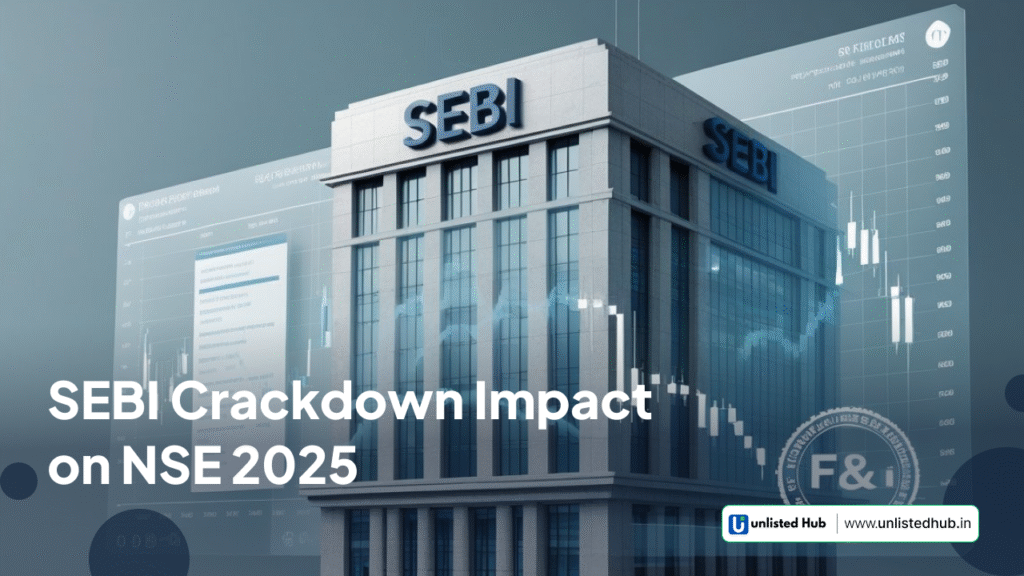Introduction:
In 2025, the SEBI FNO crackdown 2025 brought big changes to the way traders use Futures & Options—an advanced form of stock trading. SEBI introduced stricter rules to stop risky betting and protect small investors from major losses. While most headlines focused on the impact on listed derivatives, a more subtle yet significant consequence is emerging in the unlisted space, particularly around the valuation of NSE’s unlisted shares.
With SEBI tightening regulations on leveraged trading and increasing margin requirements, market participants are now redirecting their attention towards fundamentally strong assets. This shift is quietly influencing how NSE’s unlisted shares are being perceived and priced in the grey market.
This blog aims to unpack the hidden impact of the SEBI FNO crackdown 2025 on NSE’s unlisted share valuation—helping investors understand new dynamics in the unlisted ecosystem. Whether you’re a retail investor or a market observer, the SEBI FNO holds more weight than meets the eye.
A) What Is SEBI’s F&O Crackdown in 2025?
The SEBI FNO crackdown refers to a series of reforms introduced by SEBI to make Futures & Options (F&O) trading safer, especially for retail investors. With more first-time traders entering F&O through mobile apps, SEBI noticed a rise in risky trades that could lead to heavy losses.
To control this, SEBI rolled out new rules that increased the minimum lot sizes, tightened margin requirements, and placed limits on how much exposure a trader can take in the derivatives market. These steps aim to reduce reckless speculation and promote responsible trading.
One of the biggest reasons behind the SEBI FNO crackdown 2025 was the surge in retail participation without proper risk understanding. By enforcing stricter rules, SEBI hopes to bring more balance to the market. While the SEBI FNO may reduce trading volumes in the short term, it’s designed to build long-term market stability.

B) Why the FNO Segment Matters to NSE’s Business Model
The National Stock Exchange (NSE) is the country’s primary hub for derivatives trading, leading the F&O space with a commanding share of overall volume across Indian exchanges. Over the past decade, NSE has played a central role in creating the retail F&O boom by making complex trading products accessible through advanced technology and low-cost brokers.
Here’s how NSE is deeply tied to the F&O ecosystem:
- Market Leadership: NSE leads the Indian derivatives space, with a significant share of total contracts traded daily.
- F&O Trading Revenue: A major portion of NSE’s operating income comes from transaction charges in the Futures & Options segment.
- Growth via Retail Participation: The retail F&O boom has been fueled by NSE’s partnerships with digital-first brokers and platforms.
- Valuation Growth: High F&O volumes have directly contributed to a stronger NSE unlisted share valuation in recent years.
However, the SEBI FNO crackdown could shift this trajectory. With retail traders now facing stricter rules, trading volumes may decline, impacting NSE’s revenue model. The SEBI FNO crackdown 2025 doesn’t just target investor protection—it could reshape how NSE generates growth.
As NSE evaluates its dependence on F&O income, investors should track how the SEBI FNO crackdown 2025 shapes the outlook for unlisted share value and IPO timing.
C) Impact of F&O Reforms on NSE’s Core Business
The SEBI F&O crackdown 2025 has serious implications for the National Stock Exchange’s revenue model. NSE earns a large part of its income from transaction fees, especially in the Futures & Options (F&O) segment.
As SEBI introduces tighter margin rules and restricts retail participation, a dip in trading volumes is expected. This directly impacts NSE’s fee-based revenue, which could weaken in the short term.
The SEBI FNO crackdown 2025 may also slow down growth in critical revenue lines like derivatives, clearing fees, and brokerage participation. For a company preparing for its IPO, this kind of disruption can affect both near-term profitability and investor sentiment.
Here’s a quick snapshot of how NSE’s core business could be impacted:
| Impact Area | Before Crackdown | After Crackdown (Expected) |
| F&O Trading Volume | High and rapidly growing | Slower or declining |
| Fee-Based Revenue | Stable and strong | May face short-term pressure |
| Retail Participation | High | Expected to reduce |
| Profit Margins | Healthy | Could tighten temporarily |
As the SEBI FNO crackdown 2025 plays out, NSE may need to diversify its revenue mix to maintain long-term stability. The SEBI FNO is more than a regulatory move—it’s a wake-up call for NSE’s business model.
D) The Hidden Ripple Effect on NSE’s Unlisted Share Valuation
While most focus on NSE’s operating performance, the SEBI FNO crackdown 2025 has created a quiet ripple in the valuation of its unlisted shares. Investors in the private market often price companies not just on current earnings, but also on future growth and market sentiment.
As NSE’s F&O revenues come under pressure, its premium valuation in the unlisted space is also being re-evaluated.
What makes this shift more complex is perception. Even if earnings remain stable, the fear of slower growth can cause cautious pricing among pre-IPO investors. The SEBI FNO crackdown 2025 signals regulatory tightening, which may delay the aggressive expansion many had priced in earlier.
Here’s a look at how valuation factors are shifting:
| Valuation Driver | Before Crackdown | After Crackdown (Expected) |
| F&O Revenue Growth | Strong, high momentum | Likely to moderate |
| Investor Sentiment | Optimistic and IPO-driven | More cautious |
| Unlisted Share Demand | Steady with upward bias | Slight dip due to uncertainty |
| IPO Readiness Outlook | High confidence | Under reassessment |
The SEBI FNO crackdown 2025 hasn’t only affected business performance—it’s changing how the market views NSE’s potential. For many, the SEBI FNO is a reason to watch, not panic.
F) What It Means for Investors in NSE’s Unlisted Shares
The SEBI FNO crackdown 2025 has sparked concern among investors holding or planning to buy NSE’s unlisted shares. But should you panic or stay calm? Let’s break it down.
NSE earns a major chunk of its revenue from F&O transactions.A decline in F&O trading activity, triggered by the stricter norms, may reduce NSE’s revenue streams, which can indirectly influence the valuation of its unlisted shares in the private market. However, this doesn’t mean the long-term value is gone.
The SEBI FNO crackdown 2025 aims to bring stability, not destroy market potential. Investors should view this correction as an opportunity rather than a red flag. Unlisted valuations are adjusting temporarily, but NSE’s fundamentals remain solid.
Here’s a simple view to help you evaluate:
| Factor | Before Crackdown | After SEBI FNO Crackdown |
| F&O Revenue Outlook | Strong & Consistent | Short-Term Dip Expected |
| NSE Unlisted Share Demand | High | Moderately Lower |
| Valuation Trend | Upward | Temporary Correction |
| Long-Term Investment View | Positive | Still Positive |
If you’re a long-term investor, the SEBI FNO crackdown 2025 could actually help you enter at a better valuation. Monitor earnings, volumes, and investor interest to make smart decisions.
G) Expert Quote: What Market Veterans Say
Market experts believe the SEBI FNO crackdown 2025 is more than just a regulatory move—it’s a reset for long-term market health. According to Rahul Khanna, Senior Analyst at AlphaEdge Advisory, the clean-up is necessary to protect retail investors and restore balance in the derivatives market.
He points out that while the SEBI FNO crackdown 2025 might reduce NSE’s FNO trading volumes in the short term, it also pushes the exchange to diversify its income sources. This is key for building long-term stability. For investors in NSE’s unlisted shares, this phase should be seen as a window of opportunity—not a reason to panic.
Here’s how experts see it:
| Perspective | Short-Term View | Long-Term View |
| Impact of SEBI reforms | Lower F&O volumes | More balanced market structure |
| NSE unlisted share valuation | Minor correction possible | Strong growth potential |
| Investment sentiment | Cautious | Opportunistic |
The SEBI FNO crackdown 2025 may cause some valuation correction, but it does not change NSE’s strong business foundation. Smart investors should focus on fundamentals, not temporary volatility.
H) Comparative Look: Other Exchanges & Brokers at Risk
The SEBI FNO crackdown doesn’t just affect NSE—it may ripple across the entire financial ecosystem. Other major players like BSE, MCX, Zerodha, and Upstox also have significant exposure to F&O trading volumes. For brokers, F&O contributes a major share of transaction-based earnings, and a drop in volumes may lead to margin pressure.
BSE and MCX, while smaller in F&O activity compared to NSE, still depend on derivatives for growth. Similarly, online brokers like Zerodha and Upstox, who saw exponential growth through retail F&O traders, may face reduced client activity.
That said, the SEBI FNO crackdown is not a death sentence for the sector. It’s a call for evolution—pushing players to explore other revenue streams and reduce dependence on leveraged trades. While NSE might feel a stronger short-term pinch, the entire sector will need to adapt.
Here’s a quick comparison:
| Platform | F&O Exposure | Risk Level Post-SEBI F&O Crackdown 2025 | Diversification Level |
| NSE | High | Significant | Moderate |
| BSE | Moderate | Manageable | High |
| MCX | Moderate | Moderate | High |
| Zerodha | High | High | Low |
| Upstox | High | High | Low |
The SEBI F&O crackdown 2025 may level the playing field—but only those ready to innovate will sustain long-term growth.

I) SEBI’s Intent vs Market Sentiment: The Larger Picture
The SEBI FON crackdown 2025 highlights the regulator’s objective to move away from speculative trading trends and promote a more stable, investor-focused market environment. SEBI’s main goal is to protect retail traders who may not fully understand the risks of leveraged F&O positions.
However, this has caused friction with market participants who have benefited from the F&O boom.
While the crackdown has led to a dip in short-term trading volumes, it’s a step toward maturing India’s derivatives market. SEBI wants F&O to serve its original purpose—hedging, not high-risk speculation. This long-term vision may create a stronger, more resilient financial system.
For investors eyeing NSE’s unlisted shares or upcoming IPO, the SEBI FNO crackdown 2025 introduces some short-term uncertainty. However, it also ensures that the company evolves in a more regulated, stable market environment.
Here’s a balanced view:
| Aspect | SEBI’s Intent | Market Sentiment |
| Retail Protection | High priority | Seen as limiting growth |
| F&O Market Growth | Controlled and cautious | Desire for open expansion |
| Impact on NSE IPO | Improve long-term quality | Short-term valuation concern |
| Overall System Stability | Strengthened through reforms | Mixed views from participants |
The SEBI FNO crackdown 2025 may slow momentum, but it builds trust and stability for future market growth.
Conclusion: Is This a Buying Opportunity or Red Flag?
The SEBI FNO crackdown 2025 has sparked uncertainty, but it also offers perspective for investors evaluating NSE’s unlisted shares. While reduced F&O volumes may pressure short-term revenue and profits, this could drive NSE to innovate, diversify, and build a more sustainable income model in the long run.
The real question is whether the SEBI FNO crackdown 2025 is a temporary speed bump or a signal of deeper structural change.
So far, the exchange remains fundamentally strong, with market leadership, brand trust, and upcoming IPO potential. For investors with a long-term view, current price corrections in the unlisted market may actually represent a buying opportunity.
Here’s how to weigh the situation:
| Factor | Short-Term View | Long-Term View |
| Revenue Growth | Slower due to F&O pressure | May recover with diversification |
| Investor Sentiment | Cautious after regulations | Could stabilize post-adjustment |
| Unlisted Share Valuation | Slightly under pressure | May rebound pre-IPO |
| Market Position | Still dominant | Strong foundation remains |
In summary, the SEBI FNO crackdown 2025 may cause near-term discomfort, but for patient investors, it reinforces the idea that long-term strength comes from resilience. The SEBI FNO could be less of a red flag—and more of a reset.
FAQs on SEBI’s F&O Crackdown and NSE Unlisted Shares
SEBI’s F&O crackdown in 2025 aims to curb excessive retail speculation in the derivatives market by introducing higher margins, stricter eligibility criteria, and tighter exposure rules to ensure investor protection and market stability.
Yes, the reforms may reduce NSE’s revenue from F&O trading, which can impact short-term valuations of its unlisted shares. Investor sentiment may turn cautious until revenue stabilizes.
This could be a good opportunity, as the recent valuation dip—triggered by SEBI’s reforms—may offer better entry points ahead of NSE’s upcoming IPO.
Exchanges like NSE and BSE may face reduced trading volumes, impacting transaction fees and growth projections, especially for F&O-heavy platforms.
As of now, there’s no official delay. However, market conditions and F&O revenue concerns might influence investor perception and IPO pricing.
Yes, changes in F&O regulations can affect revenue forecasts of companies like NSE, which may lead to short-term corrections in pre-IPO share valuations.
You can buy NSE unlisted shares through trusted platforms like Unlisted Hub or SEBI-registered intermediaries that offer verified pricing and secure transactions.
Yes, NSE remains fundamentally strong. While short-term valuation may fluctuate, long-term growth potential makes it a promising pre-IPO investment.
By: Virag Mehta | Financial Research Analyst
Disclaimer: This article is for informational purposes only. Please consult a financial advisor before making any investment decisions.


